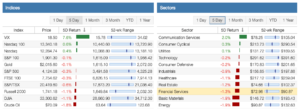Optimizing Your Asset Allocation
When to buy a stock and at what price are very important decisions. However, serious investors will tell you the most important decision is how you allocate your assets. Many people step back and look at their asset allocation and how it needs to change as they approach retirement.
The first significant question you have to answer is how much do you allocate to equities and cash/fixed income. There are many approaches to answer this question, but the vast majority of investors following an asset allocation model use one of these two approaches:
I. Fixed Income % = Age
This approach by far is the most popular among conservative investors. One of its most prominent proponents is Vanguard Group’s founder Jack Bogle. It is very simple to implement. Each year you increase your allocation to cash/fixed income one percentage point to match your age and decrease your equity allocation one percentage point.II. Equity % = 120 – Age
More aggressive investors choose this approach. The theory here is that equities have out-performed fixed income historically and this formula keeps you in a higher percentage of equities over your life cycle. Using this formula, you would have no fixed income allocation until you are 21 years old. It too is easy to implement; simply subtract your age from 120 and the resulting amount is the percentage that is allocated to equities with the remainder going to cash/fixed income.
After determining your equity/fixed income split. The next step is to decide what type of investments belong in the equity portion of your allocation. Traditional splits are based on capitalization (large/mid/small cap), origin (domestic vs. international) and sectors such as financials, healthcare, energy, etc. I chose a mixture of all the above. I look at 12 sectors as defined by Morningstar, plus real estate. In addition, I look at origin and capitalization. I review my allocation on a quarterly basis.
After much modeling, I determined my allocation. I put together an Excel model (D4L-Calc-Asset-Allocation.xls) for illustrative purposes of modeling my asset allocation over time. You may want to use it as a starting point for developing your asset allocation. Here is a quick overview of how to use the model:
Input Section
– Year of birth: When you were you born?
– Fixed/Cash Status: Enter 1 (age) or 2 (120-age) here to select one of the two fixed income options described above.
– Age Override: Let you see what your allocation looks like at any age.
– Equities-Domestic: Percentage of the equity portion allocated to Domestic Equity
– Equities-International: Percentage of the equity portion allocated to International Equity
– Employer Equity: Percentage of the equity portion allocated to Employer Equity
– Small/Mid-Cap: Percentage of the equity holdings allocated to Small/Mid-Cap Equity
The sum of Equities-Domestic, Equities-International and Employer Equity should equal 100%. The sections in the model below the Input section calculate the allocation percentages based on your inputs. Periodically, you will need to reevaluate the appropriateness of the Small/Mid-Cap allocation since it does not automatically adjust annually.
Let’s consider some sample investments that would fall into each of these categories:
Cash/Fixed Income:
– Money Market Accounts
– Vanguard Long-Term Bond ETF (BLV)
– Vanguard Intermediate-Term Bond ETF (BIV)
– iShares Investment Grade Corp Bond ETF (LQD)
Equities-Domestic (U.S. for me):
– S&P Index ETF (SPY)
– Johnson & Johnson (JNJ)
– The Coca-Cola Company (KO)
– 3M Co. (MMM)
Equities-International:
– iShares MSCI EAFE Index (EFA)
– Vanguard Emerging Markets Stock ETF (VWO)
– Vanguard FTSE All-World ex-US ETF (VEU)
– Vanguard Total World Stock Index ETF (VT)
Large-Cap:
The securities listed above under Equities-Domestic are all Large-Cap.
Small/Mid-Cap:
– Vanguard Small Cap ETF (VB)
– Vanguard Mid Cap ETF (VO)
– Genuine Parts Co. (GPC)
– Clorox Corporation (CLX)
Employer Equity:
Obviously, this would include stock in the company you work for. It would also include stock options, SOSARs (Stock Only Stock Appreciation Rights) restricted stock and company stock in your 401(k).
As Charlie Munger, Warren Buffett ’s long-time friend and partner said, “Allocate assets wisely. Proper allocation of capital is an investor’s No. 1 job.”
iShares MSCI EAFE Index (EFA)
Full Disclosure: Long JNJ, KO, MMM, GPC, in my Dividend Growth Stocks Portfolio.
Related Articles
Tags: BLV, BIV, LQD, SPY, JNJ, KO, MMM, EFA, VWO, VEU, VT, VB, VO, GPC, CLX,
Published at Mon, 14 Mar 2022 23:00:00 -0700






